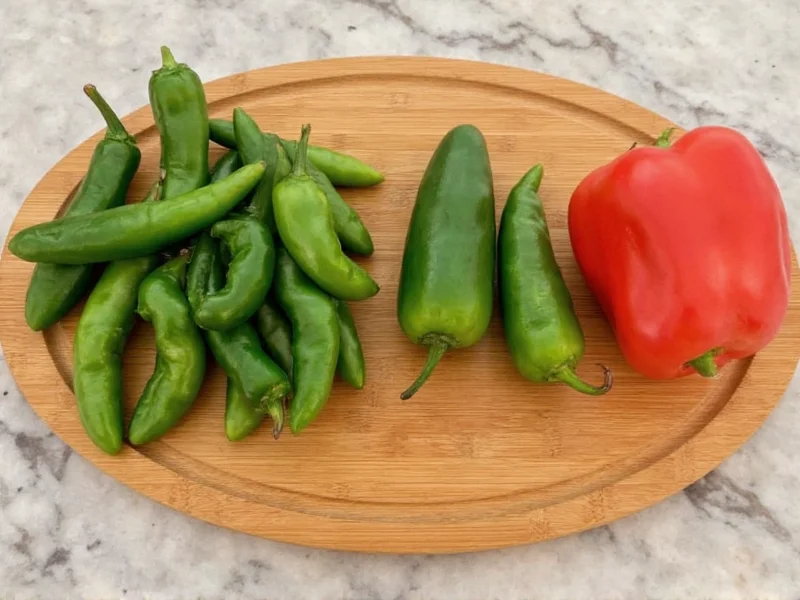Serrano peppers, scientifically known as Capsicum annuum, have become a staple in kitchens worldwide for their distinctive heat and flavor profile. These slender, 1-4 inch peppers pack significantly more punch than jalapeños but offer a cleaner, brighter taste that enhances rather than dominates dishes. Understanding what to use serrano peppers for requires knowing their unique characteristics and how they behave in different culinary applications.
Understanding Serrano Pepper Characteristics
Serrano peppers typically measure between 10,000 and 23,000 Scoville Heat Units (SHU), making them two to four times hotter than jalapeños. Their flavor profile features a bright, grassy note with subtle citrus undertones that distinguish them from other chili varieties. Unlike habaneros or ghost peppers that deliver intense fruity notes with extreme heat, serranos provide a cleaner heat that allows other ingredients to shine through.
| Pepper Type | Scoville Range | Flavor Profile | Best Culinary Uses |
|---|---|---|---|
| Serrano | 10,000-23,000 SHU | Bright, grassy, citrus notes | Raw salsas, sauces, pickling |
| Jalapeño | 2,500-8,000 SHU | Grassy, slightly sweet | Stuffed peppers, nachos, milder salsas |
| Habanero | 100,000-350,000 SHU | Fruity, floral, tropical | Hot sauces, Caribbean dishes |
| Cayenne | 30,000-50,000 SHU | Sharp, earthy | Dried spice, cooked sauces |
Top Culinary Applications for Serrano Peppers
Raw Preparations: Salsas and Fresh Sauces
When considering what to use serrano peppers for, raw applications represent their strongest suit. Their crisp texture and bright flavor shine in fresh preparations where cooking would diminish their distinctive characteristics. Pico de gallo, salsa verde, and guacamole all benefit from finely diced serranos added just before serving. For balanced heat distribution, remove seeds and membranes (where most capsaicin resides) before chopping.
Professional chefs often recommend using serrano peppers for salsas when you want noticeable heat without the smokiness of chipotles or the fruitiness of habaneros. The clean heat profile allows other fresh ingredients like tomatoes, cilantro, and lime to maintain their prominence in the finished dish.
Pickling Serrano Peppers for Versatile Heat
Pickled serrano peppers serve as an excellent condiment that preserves their heat while mellowing their raw intensity. The pickling process transforms serranos into a versatile ingredient perfect for topping tacos, adding to Bloody Mary cocktails, or incorporating into Mexican-style potato salads. Unlike jalapeños which develop a sweeter profile when pickled, serranos maintain their distinctive grassy notes with a pleasant vinegary tang.
When preparing pickled serranos, many home cooks wonder how to use serrano peppers effectively in this form. The answer lies in their versatility—they work equally well as a garnish, blended into sauces, or even chopped into deviled eggs for an unexpected kick.
Cooking Techniques for Optimal Flavor
Understanding how to use fresh serrano peppers in cooked dishes requires attention to timing. Unlike bell peppers which benefit from longer cooking, serranos lose their distinctive flavor when exposed to heat for extended periods. For best results, add serranos during the final 5-10 minutes of cooking to preserve their bright characteristics.
When substituting serrano peppers in recipes that call for milder chilies, remember that serranos deliver significantly more heat. A general rule for serrano pepper substitution in recipes is to use half the amount of serranos compared to jalapeños. For example, if a recipe calls for two jalapeños, use just one serrano to achieve similar heat levels while gaining the distinctive serrano flavor.
Preserving Serrano Peppers for Year-Round Use
When gardeners or market shoppers face an abundance of serrano peppers, proper preservation extends their usability. Freezing whole peppers maintains their heat profile better than drying, which concentrates the capsaicin and intensifies the heat. For those wondering how to handle hot serrano peppers safely during preservation, wearing gloves prevents skin irritation from capsaicin oils.
Another effective preservation method involves blending serranos with oil and freezing in ice cube trays—a technique particularly useful for what to use serrano peppers for in cooking throughout the year. These frozen pepper cubes easily drop into soups, stews, and sauces without thawing.
Serrano Pepper Safety and Handling Tips
Working with serrano peppers requires precautions due to their significant heat level. Always wear disposable gloves when handling serranos, especially when removing seeds and membranes. Never touch your face or eyes after handling hot peppers, and wash all utensils and surfaces thoroughly with soapy water afterward.
If you experience skin irritation from serrano peppers, apply milk or yogurt to the affected area—capsaicin dissolves in fats but not in water. For severe reactions, consult a healthcare professional. These safety considerations represent an essential aspect of what to use serrano peppers for in your kitchen.
Recipe Ideas Featuring Serrano Peppers
For immediate applications of what to use serrano peppers for, try these simple preparations:
- Serrano-Lime Crema: Blend 2 chopped serranos with 1 cup sour cream, juice of 2 limes, and salt. Perfect for tacos or as a dip.
- Avocado Serrano Smoothie: Combine 1 seeded serrano with 1 avocado, 1 cup spinach, 1 banana, and almond milk for a nutrient-packed beverage with subtle heat.
- Serrano Infused Olive Oil: Gently heat 1 cup olive oil with 3-4 whole serranos for 10 minutes (do not boil), then strain. Use for dipping bread or finishing dishes.
Storage Recommendations for Maximum Freshness
Store fresh serrano peppers in the crisper drawer of your refrigerator for up to three weeks. For longer storage, freeze whole peppers in airtight containers for up to six months. Unlike jalapeños which develop wrinkles when stored, serranos maintain their firm texture longer, making visual inspection an effective method for determining freshness.











 浙公网安备
33010002000092号
浙公网安备
33010002000092号 浙B2-20120091-4
浙B2-20120091-4